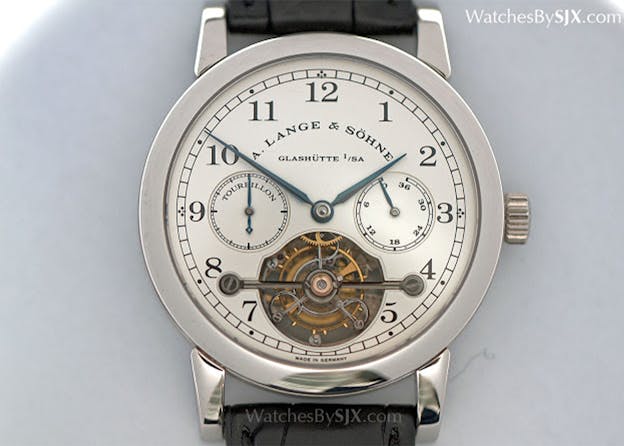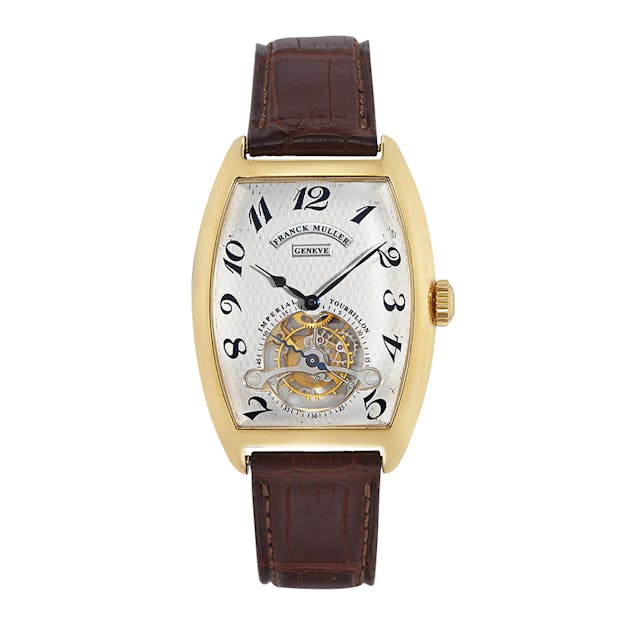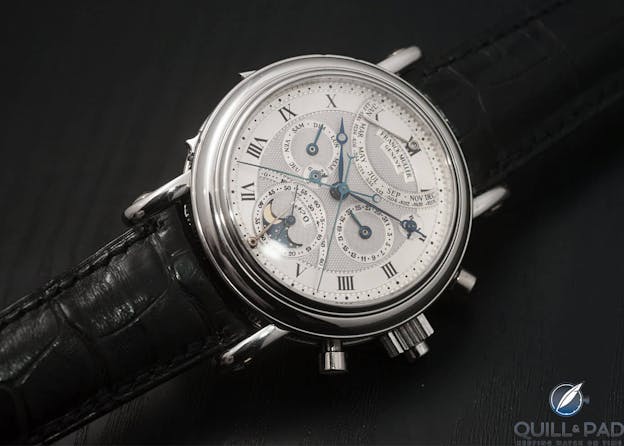Tourbillon Chronicles Part III: Rise of the Wristwatch
The last word in pocket watch accuracy becomes the first name in wristwatch complications.
In the late 1970s, as we (probably) all know, things were looking a little grim for the mechanical watch industry in Switzerland. Most watch enthusiasts know what the term, Quartz Crisis, means but it’s harder to imagine with every passing year just how rough it was. Between 1970 and 1988, headcount in the watch industry dropped from about 90,000 to about 28,000. It’s easy to just call it the Quartz Crisis and leave it at that, and for sure, the advent of mass-producible quartz watches didn’t help, but the collapse of the industry happened for more complicated reasons, as Europa Star reported in a look back in July of 2022 (and if you’re really interested in what went down, including how the Swatch actually helped save the industry, check out what accomplished watch journalist, Joe Thompson, has to say on the Quartz Revolution and the Mechanical Renaissance).
However, if you were sharp, in the watch industry and had an entrepreneurial bent, you might have remembered the old saying, “The Chinese use two brush strokes to write the word ‘crisis.’ One brush stroke stands for danger; the other for opportunity.” The quote is supposed to have originated with JFK, who is also supposed to have gotten his facts slightly wrong, but, as the watch industry will surely appreciate, never let the facts ruin a good story. The mechanical watch, maybe, was no longer and would never again be the last word in actual precision timekeeping but what it could offer was something quartz watches could not — a connection to history, to tradition, to craft and to exactly the sort of minute variations in detail which are catnip to anyone born with the genetic makeup of a real collector.
And that’s where the tourbillon comes in. Tourbillons, as you may recall from our last installment, were rarer than hen’s teeth for decades after the ink dried on Breguet’s patent. They were almost exclusively produced for pocket watches when they were made at all, and you could almost count the number of wristwatch tourbillons made until the mid-1980s on the fingers of, if not one, then many two (two and a half) hands. A lot of the time wristwatch tourbillon movements were made just for the wristwatch caliber category in observatory competitions and they never got cased at all. There was simply no market for such a thing and given the amount of time, energy and effort it took to make them, it didn’t look, as the 1970s drew to a close and the 1980s opened, as if there ever would be a market; you can’t have a market when there is little product of any kind, and when most of the existing product is either sitting in company archives or in museums (or, at least in one case, on the wrist of Philippe Stern).
By 1990, Thompson, by his own account, would be able to write, “The mechanical watch has made a Lazarus-like return at the upper end of the market, and is a major feature of the Swiss renaissance. Mechanical watch exports are up 44% in the past two years, to $1.5 billion.”
This is getting ahead of ourselves a little bit but it goes to show just how sharp the rebound was once the Swiss watch industry hit its stride. Years before that turning point, however, watches started to come out of Switzerland which put the tourbillon front and center in actual production watches — production wristwatches.
One of the first out of the gate was, as everyone ought to know, Audemars Piguet. The first series produced, automatic tourbillon wristwatch and for many decades the absolute thinnest automatic tourbillon wristwatch and thinnest tourbillon watch of any kind, came in 1986 out of what was then still a fairly sleepy little town in the Jura called Le Brassus (which is far, far more widely famed today than its founders ever dreamed it would be although in the interests of candor, it’s still pretty darned sleepy).

That watch was the Audemars Piguet reference 25643, which nominally used the AP caliber 2870. I say “nominally” because the 25643 did not actually have a movement in the usual sense; there was no self-contained mechanism with a mainplate and bridges held inside a conventional case. Instead, the case was the movement, or at least part of it. The back of the case itself functioned as the movement plate and you can, if you look at the back of one of these watches (if you ever get to see one), actually see the jewels for the train pivots protruding through the caseback. The watch was only 4.8mm thick and all the innards were on the same plane, including the hammer winding system. This is pretty much the only way you can get around the limiting factors involved in making an ultra-thin watch with a conventional movement and, in fact, record breaking ultra-thin watches ever since then have often used a similar strategy. To keep the weight down and reduce inertia, the tourbillon cage was made of titanium.
The watch was not exactly a poster child for precision timekeeping and the hammer-winding system was not super-efficient (the crown, on the back of the watch, was just for setting the time; to wind the mainspring you had to swing the 25643 back and forth like the lowliest Seiko 5) but it was a first on many levels and a milestone for AP and the watch world.
In 1988 a couple of things happened, and they both involved Daniel Roth. First of all, Breguet – whose revival as a bona fide fine watchmaking brand whose identity would stop the Founder from spinning in his grave (at Pére Lachaise Division 11 in Paris, if you’re in the mood for a pilgrimage) got into the wrist-tourbillon game. That year saw the release of Breguet’s first tourbillon wristwatch ever; this was the reference 3550.

Breguet Ref. 3350. Image, Phillips
Later that same year, Daniel Roth released his first watch under his own name. He used the same basic movement design as he’d used for Breguet but in a quite dramatically different case. The design of both watches reflected the prevailing sentiment among collectors at the time — that the tourbillon should look and feel as much like an elevated and honorable descendant of Breguet as possible (a notion to which AP did not subscribe, which may have had something to do with the lack of universal acclaim when the 25643 launched, and the sober classicism of AP’s following tourbillon wristwatches).
Another major shot fired in the 1980s came from none other than the resurrected Blancpain, which had been brought back to life by Jean-Claude Biver to showcase F. Piguet movements. Blancpain’s reference 0023 flying tourbillon was launched in 1989, with a tourbillon designed by AHCI member Vincent Calabrese, featuring a then-unique design with a cage and balance on two separate axes. An eight-day power reserve too, the watch was at least a decade before long-power reserve wristwatches started to become a major selling point for luxury watch brands.

The plot, as plots do, thickened considerably in the 1990s — and while it becomes harder and harder to be anything like comprehensive, there were some major, obvious high points.
In 1991, Girard-Perregaux launched a wristwatch version of its famous (in the then still very small world of tourbillon enthusiasts) tourbillon under three golden bridges — it was called the Président, and was based, in terms of movement design, on GP’s pocket tourbillons, including a very limited series of 20, launched in 1981 (GP in its past was one of the most famous makers of pocket tourbillons in Switzerland).

1991 was also the year that François-Paul Journe showed his very first Tourbillon Souverain wristwatch — it was a prototype, and the Souscription series wouldn’t follow until 1999 but he had the watch at Baselworld, where none other than Günter Blümlein, the man responsible for, among other things, the rebirth of A. Lange & Söhne, expressed interest and proposed to Journe that he make a series, for IWC, of 125 for IWC’s 125th birthday. The proposal did not, obviously, pan out, but it is interesting to wonder what would have happened if it had.
The Tourbillon Souverain was the first wristwatch tourbillon with the constant force mechanism known as a remontoir and had beat dead seconds too. Although it was a bit of a long slow burn between the prototype and the Souscription, as Journe would undoubtedly agree, you can’t rush art, and he was after nothing less than the wristwatch as a form of personal and artistic expression.

Speaking of IWC, in 1993 the company launched what was then by far the most complex, expensive and all around impressive complicated watch it had ever made. IWC had already launched a Grande Complication at BaselWorld in 1990, but this was one step further — Il Destriero Scafusia (the name means, hold on to your knickers, “The Warhorse Of Schaffhausen”) was a rattrapante chronograph, perpetual calendar with four digit year indication, minute repeater and tourbillon, with a titanium cage and rattrapante mechanism designed by Richard Habring, who of course has gone on to have an incredibly distinguished career as an independent watchmaker.

And then there is Gerald Genta. Genta is so famous these days as a watch designer that his name in association with any particular watch design has become almost a license to print money — which by the way is not a knock on him as a designer. In fact it’s exactly the opposite; he’s arguably the single most influential watch designer in history and has a strong claim to being the man who actually made designing watches a respected creative profession (generally speaking the watch industry has not particularly wanted individuals to shine too bright lest they outshine the Brand and while that has changed to some degree over the years, a lot of them still don’t).
Genta’s tourbillon was in his Grande Et Petite Sonnerie Perpetual Calendar Tourbillon with Chimes Of Westminster, and it’s self-winding on top of everything else. The watch is one of the craziest things I’ve ever seen and has a visual impact out of all proportion to its 39mm size. It looks like a sort of miniature Mayan step-pyramid packed to the gills with over 1000 parts, each finished to within an inch of its life. After having known about it for, god, it must be close to 30 years; the watch came out in 1994, I finally got to see one of the three that were made and I felt like I had met a celebrity. Kids, you won’t believe it, but in 1994 this was one of the highest pinnacles of fine watchmaking, now get the hell off my lawn.

You know what else happened in 1994? A small town in Germany played host to the rebirth of a brand that not many people at all had ever heard of up until that point — A. Lange & Söhne. The company showed four watches as its first collection, and one of them was a watch that will always have a place in the pantheon of pioneering tourbillon wristwatches: the Tourbillon Pour Le Mérite.

This watch, in contrast to some other first-gen tourbillon wristwatches, did not make the tourbillon an ensemble player in a multi-complication watch. No, this was a tourbillon lover’s tourbillon, with a cage based on the Jahrhunderttourbillon, made by Fridolin Stübner and shown, in 1900, at the Paris World Exhibition. It was a 38.5mm x 10mm watch (lest we forget this was still a time when making a highly complicated watch in manageable, even classic, dimensions was a point of pride) and it remains one of the most beautiful things the brand has ever produced; a benchmark for pure tourbillon wristwatches.
I can’t personally neglect to mention just two more watches — one series produced, and the other a one-off that is one of the most obsessive years-long examples of connoisseurship as an exercise in patience as I have ever seen. The first is the Franck Muller Tourbillon “Imperiale” and while, God knows, Franck Muller has had his ups and downs, he is indisputably one of the great watchmakers and defining entrepreneurs of the mechanical fine watchmaking renaissance; this was his first tourbillon (in 1996 he released an update with a minute repeater included).

Franck Muller was also involved in a watch which, when I was getting to know it through its owner’s activity on ThePuristS.com, was known by the somewhat unwieldy name of the “Piguet/Muller/Gerber Grand Complication.” The watch started life as a movement — a 32mm, minute repeater grande et petite sonnerie, made by Louis-Elysée Piguet in 1892. The movement surfaced a hundred years later and, at the request of the then-owner, Franck Muller added several complications to what was already a pretty damned complicated watch, including a perpetual calendar with moonphase and a thermometer.
Franck Muller showed the watch at BaselWorld in 1992 but the owner was not yet satisfied (I don’t think as far as I remember that he ever regarded the project as actually finished; his goal was to own nothing less than the indisputable official record-holder for most complicated wristwatch in the world). I remember him as the soul of cordiality in every respect unless you happened to make the mistake of suggesting that another wristwatch might be more complicated. As a manifestation of this dissatisfaction he asked independent watchmaker Paul Gerber (who is still in business and makes one of the very few spherical moonphase watches in production — and he’s been making them for decades) to build a flying tourbillon into the movement, which Gerber at great risk managed to do without increasing the movement height. Making room for the tourbillon meant milling out the baseplate, which if mishandled even slightly would have destroyed the watch. Gerber showed the watch at Basel in 1995 and later the owner would send the watch back to Gerber to have a, for-crying-out-loud, rattrapante chronograph added to what any reasonable, or even unreasonable, person would concede was an already packed mechanism, and after that the watch went back to Gerber again to have a diamond endstone added to the tourbillon.
The watch has passed into the hands of a new owner, who sent it back to Gerber to be completely disassembled and to have the finish updated and upgraded. The entire saga is both a little exhausting to read and extremely exhilarating; the watch is now called the Superbia Humanitas.

It may be a one off, but what a one off — and it is in a way a kind of pinnacle of a certain approach to horology current in the heady days of the 1990s, when connoisseurship in watches really did mean a knowledge of watchmaking. It is also a watch deliberately and firmly rooted in classic watchmaking skill and methodology, as well as aesthetics, and I genuinely wonder if there is anyone who would take on such a project nowaday, or even anyone who could, especially without modern machine tools and CAD. Along with its contemporaries, it represents just how much collectors 30 years ago expected the tourbillon to be part of a long history of austere and challenging hand-craft going all the way back to Breguet.
What I think a lot of us were not particularly expecting, and which was waiting in the wings for the new century, was a little something called the Freak.


